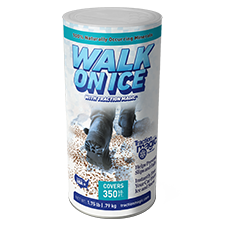Using Vaporizer Ice Melt On Your Concrete Driveway – Read This First
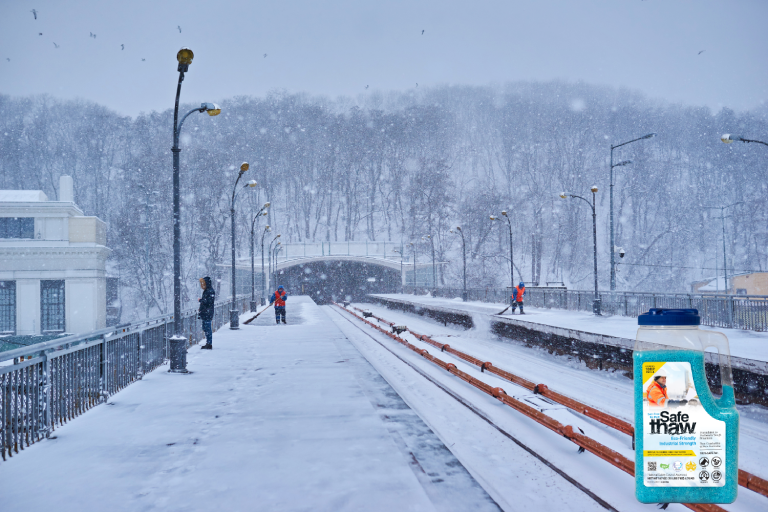
A lot of people don’t know this, but concrete driveways can be a huge problem when it comes to ice melting. You may have used rock salt in the past or even a chemical ice melter, but those products can damage your driveway and leave it looking dingy and dirty. While it may seem like just a simple slab of concrete, it can actually be a lot more than that—and making sure you use the right product on it can make a big difference.
Does Driveway Ice Melter Damage Concrete?
While many driveway ice melters are safe for concrete when used correctly, some can potentially damage concrete surfaces over time. This damage can occur due to a few reasons:
- Chemical Composition: Some ice melters for driveway contain harsh chemicals, like calcium chloride or magnesium chloride, which, if overused or misapplied, can affect the structural integrity of concrete.
- Frequency of Use: Excessive or frequent application of ice melters can increase the risk of damage to concrete.
- Temperature Extremes: Rapid freezing and thawing cycles can also weaken concrete, especially if it’s not properly sealed.
Environmental Impact of Ice Melt Products
The Hidden Ecological Costs of Common Ice Melts
Traditional ice melt products, like those containing sodium chloride and calcium chloride, may effectively clear ice but can have adverse effects on the environment:
- Water Contamination: Runoff from chloride-based ice melts pollutes rivers and groundwater, endangering aquatic life.
- Soil Degradation: Overuse of these products alters soil composition, reducing fertility and harming vegetation.
- Damage to Ecosystems: Residual chemicals affect local flora and fauna, disrupting ecosystems around your property.
Pet and Child Safety Considerations
Risks of Traditional Ice Melt Ingredients
Many ice melts include chemicals that can harm pets and children:
- Skin and Paw Irritation: Chloride compounds can cause burns or rashes on skin or paws.
- Toxic Ingestion: If accidentally ingested, these products can lead to vomiting, diarrhea, or worse.
Benefits of Non-Toxic Ice Melts
Using non-toxic, pet- and child-safe options like Safe Thaw ensures:
- Peace of mind for families with children and pets.
- No harmful side effects from accidental contact or ingestion.
- A safer, more sustainable winter maintenance routine.
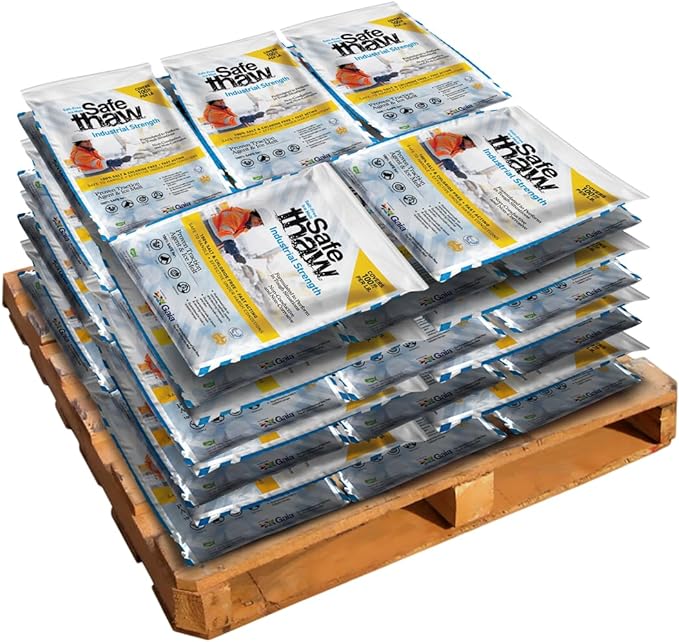
40 Bags
Safe Paw Thaw Industrial Strength Salt-Free Pet Safe Snow Ice Melter and Traction Agent for Concrete, Asphalt, Decks, Lawns, and More, 43 Pound Bag- 40 Bags
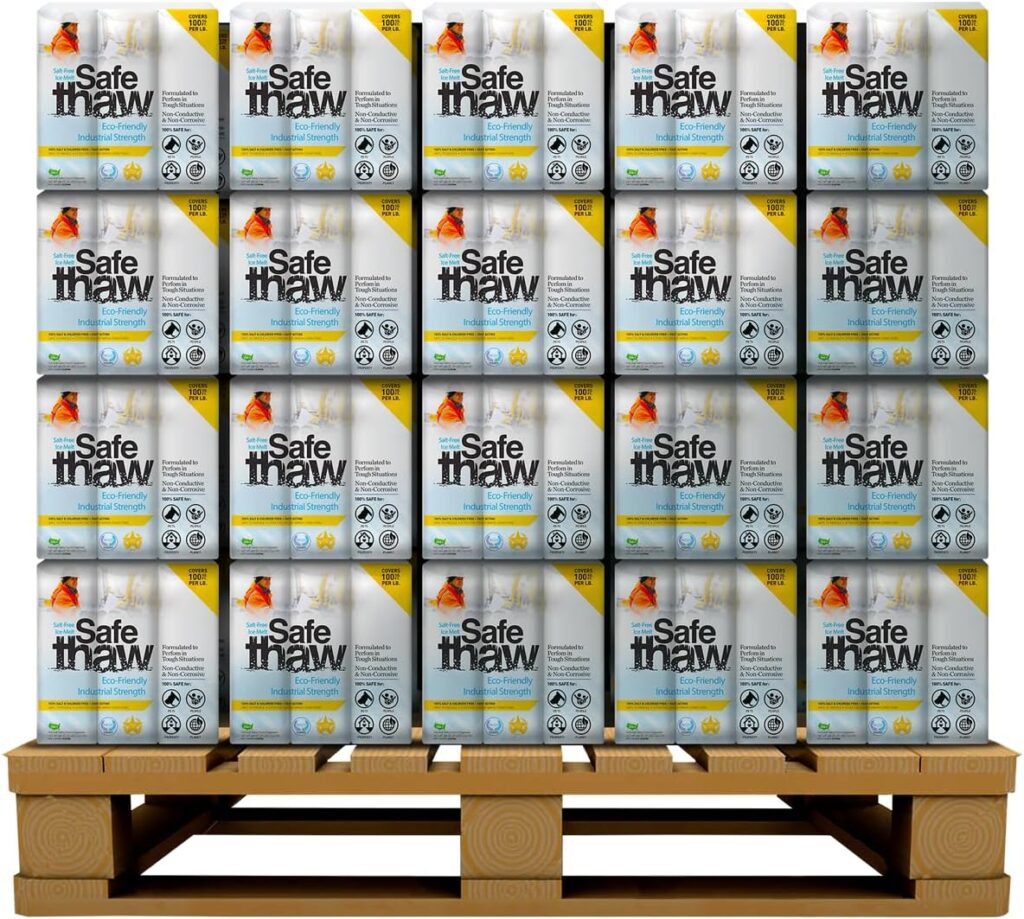
100 Boxes
Safe Thaw Industrial Strength 100% Salt/Chloride-Free, Pet/Paw-Safe Snow & Ice Melter and Traction Agent. Use on Concrete, Asphalt, Roofs & On Any Surface, 30 Pound FlexiPail- 100 Boxes
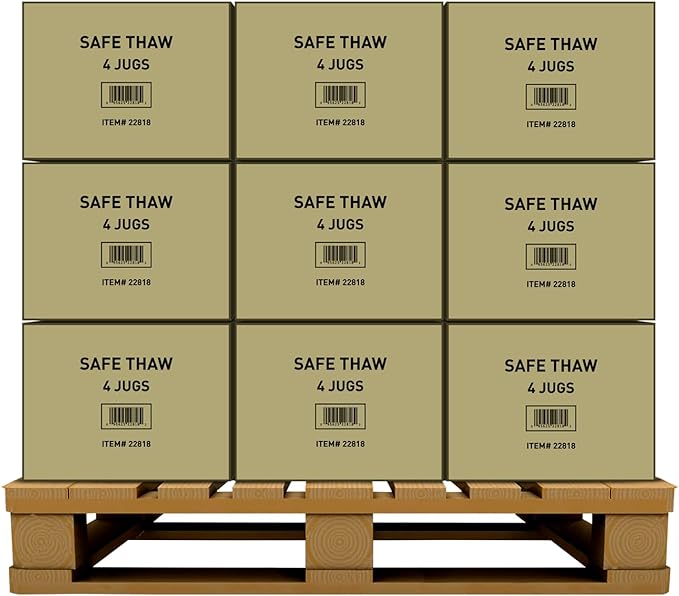
105 Jugs
Safe Thaw Concrete Safe 100% Salt-Free, Pet Safe Snow and ice Melter, Industrial Strength, Chloride-Free, and Traction Agent. Use on Asphalt, Roofs & On Any Surface, 10 Pound Jug- 105 Jugs
How to Melt Dry Ice Safely on Your Concrete Driveway
Winter can wreak havoc on concrete driveways if not properly maintained. While dry ice is a unique tool for certain situations, understanding how to use it alongside concrete-safe ice melt products can prevent long-term damage. This guide explores the safe use of ice melts, their environmental impact, and proper application techniques for protecting your driveway.
Choosing Eco-Friendly Alternatives
Switching to environmentally safe products like Safe Thaw helps:
- Protect nearby plants and waterways.
- Maintain soil health.
- Reduce your environmental footprint while ensuring effective ice management.
Proper Application Techniques for Ice Melt
Why Proper Application Matters
Even concrete-safe ice melt products can cause damage if misused. Correct application not only protects your driveway but also enhances the efficiency of the product.
Guidelines for Safe and Effective Application
- Clear the Area First: Remove as much snow and loose ice as possible using a shovel or snow blower.
- Apply Evenly: Scatter the ice melt evenly across the surface, avoiding large piles. Excessive concentration in one spot can lead to overuse and damage.
- Follow Recommended Quantities: Read the product label for the proper amount to use based on the area size.
- Avoid Overuse: Using too much ice melt can lead to product runoff, increasing environmental and concrete risks.
- Sweep Up Residual Product: Once the ice has melted, sweep up any remaining material to prevent chemical buildup.
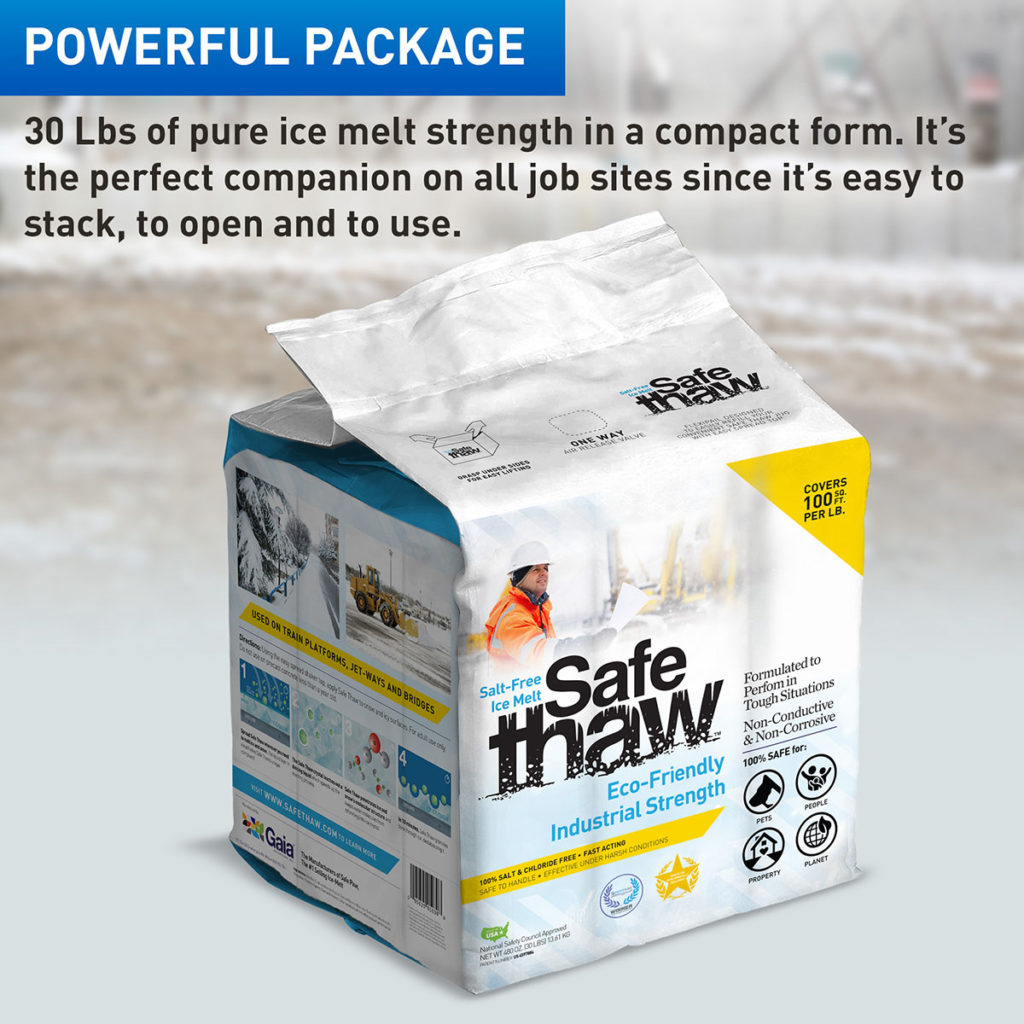
Safe Thaw
Safe Thaw was created as the ice management solution for tough winter environments. Ideal in commercial and industrial properties, shops, government agencies, bridges, and construction.
What Is The Best Way To Melt Ice?
Over the years, we studied our customers and analyzed their pain points to develop our unique product offering that is 100% salt-free, chloride-free, and safe for the environment, pets, and kids. Safe Thaw is a unique dual-patented urea-modified ice melt product containing harmless glycols and special surfactants. It has soft ice-melting boosters that break the icy layer as it comes in contact with it and works even below zero degrees.
To minimize the risk of concrete damage, it’s essential to choose an ice melter like Vaporizer Ice Melt, which is designed to be safe for concrete and follow the recommended application rates.
But if you have been wondering is vaporizer ice melt safe for concrete or planning to use one, keep these things in mind.
Vaporizer Ice Melt is designed to be safe for concrete surfaces, making it an excellent choice for homeowners looking to protect their driveways. This product is formulated to melt ice efficiently without causing damage to concrete when used according to the manufacturer’s instructions. It has a patented dual-effect formula that helps break the surface tension of ice, speeding up the melting process.
- It Is A Blended Product: They come in different packages and compositions that may confuse a new buyer. It contains calcium chloride and sodium chloride, which is not 100% safe for the environment. It may break the ice relatively quickly, but over time it may harm your plants and vegetation.
- It Contains Sodium Chloride: What is the best way to melt ice is often answered by many by resorting to high concentrations of different chlorides? Vaporizer ice melt product contains a liberal amount of sodium chloride and rock salt, which is harmful to the environment and may damage concrete if overused.
- It Can Stain Your Concrete: There is a high chance of the pellets or flakes staining the concrete as it leaves a light residue after drying up. You may need help cleaning or covering it up, increasing your job, and investing a tangible amount.
- It Has Different Product Categories: Is vaporizer ice melt safe for concrete depends on the product you choose from the range of products. There is a high chance of purchasing rock salt or a 100% sodium chloride product that will harm your concrete and the surroundings in the long run.
- It Is Not Pet And Kid Safe: Calcium chloride mixed with sodium chloride irritates the skin and may burn your pets’ paws. If accidentally ingested, it may cause stomach problems. You have to be careful all the time.
100% salt & chloride-free, fast acting Ice Management Solution
How Do You Neutralize Ice Melts on Concrete?
To neutralize ice melts on concrete and prevent potential damage, follow these steps:
- Sweep and Remove: Begin by sweeping away any remaining ice and snow on the concrete surface.
- Rinse with Water: Thoroughly rinse the concrete with water to remove any residue from the ice melter. Use a hose or a bucket of water to ensure complete coverage.
- Scrub if Necessary: For stubborn residues, scrub the area gently with a brush. Avoid using wire brushes or abrasive materials that could damage the concrete.
- Repeat as Needed: Depending on the severity of the residue, you may need to repeat the rinsing process until the concrete is clean.
Why Concrete-Safe Ice Melt is Essential
Protecting Your Driveway
Concrete, especially new or untreated surfaces, is susceptible to damage from harsh chemicals in traditional ice melt. Products labeled as concrete safe ice melt, such as Safe Thaw, prevent:
- Scaling and Spalling: Avoid surface flaking caused by chemical reactions.
- Cracking: Minimize freeze-thaw cycle damage with non-corrosive formulas.
Best Practices for Longevity
- Seal your driveway every 2–3 years to create a barrier against moisture and deicing chemicals.
- Use ice melt for concrete designed specifically for treated and untreated concrete surfaces.
- Monitor your driveway for signs of damage and address them promptly.
The Role of Dry Ice in Winter Maintenance
Dry ice, primarily used for industrial cooling, can have unique applications in managing ice buildup. However, it is not a substitute for traditional ice melts due to its unique properties:
- Rapid Sublimation: Dry ice turns directly from solid to gas, which can reduce ice without leaving residue.
- Concrete Concerns: Direct application of dry ice on concrete can cause thermal shock, leading to cracking or weakening.
How to Use Dry Ice Safely
- Use gloves to handle dry ice to prevent frostbite.
- Apply in small, controlled amounts to avoid damage to the concrete surface.
- Follow up with a concrete-safe ice melt for comprehensive ice removal and protection.
Understanding Dry Ice Beyond Ice Melt-How to Dispose of Dry Ice
Now that we’ve explored vaporizer ice melt and its potential effects on concrete, it’s worth looking at how dry ice interacts with winter maintenance. Many people wonder: what’s the dry ice evaporation rate, or how long does the dry ice melting time really last when used outdoors? Unlike chemical ice melts, dry ice doesn’t technically “melt.” Instead, it sublimates—meaning it changes directly from solid to gas. This makes it unique but also unpredictable on driveways. In practical terms, the rate of sublimation depends on temperature, surface contact, and even air circulation. On average, a block of dry ice left exposed can disappear within 12 to 24 hours, but small pellets may vanish in just a few hours. This isn’t always practical when you’re trying to keep a concrete driveway safe, because sublimation leaves no brine behind to help with traction.
How to Dispose of Dry Ice Safely on Concrete Surfaces
Here’s where confusion often arises: how to dispose of dry ice once it’s served its purpose. Unlike salt or chloride-based ice melts that leave a visible residue, dry ice leaves nothing but carbon dioxide gas. But improper disposal can still be dangerous. You should never toss chunks directly onto concrete or asphalt and walk away, because rapid sublimation can cause extreme cold spots that shock the surface, potentially leading to small cracks. Instead, the safest method is to let dry ice evaporate in a well-ventilated outdoor area, away from direct contact with fragile materials. A plastic container or insulated cooler left partially open works well to control the sublimation rate without risking damage to your driveway.
Dry Ice and Winter Driveway Safety: What You Need to Know
It’s easy to think that faster is always better when tackling ice. But is dry ice really the fastest way to clear a surface? The truth is, the dry ice melting time can sometimes feel quicker because sublimation looks dramatic. However, because it doesn’t create liquid to break the bond between ice and concrete, it won’t prevent refreezing. That’s why most professionals prefer concrete-safe chemical melts over dry ice. While dry ice has industrial uses—from shipping perishables to cleaning equipment—it isn’t always the practical solution for a slick driveway. Instead, it’s better thought of as a short-term tool rather than a long-term fix.
Comparing Dry Ice with Concrete-Safe Ice Melts
A natural question is: why not combine both? Could you use dry ice to break tough patches and then apply a concrete-safe ice melt for long-lasting results? The answer is yes—with caution. By letting dry ice reduce thick buildup and then switching to a product designed to melt and protect concrete, you can achieve a balance of speed and safety. But you need to keep in mind the dry ice evaporation rate: once it’s gone, it’s gone. Unlike Safe Thaw or other chloride-free solutions that remain active, dry ice leaves nothing to sustain traction or prevent new ice from forming.
Practical Advice for Everyday Users
If you’re still wondering how to dispose of dry ice at the end of a winter day, the safest way is patience. Leave it outside in a shaded, ventilated spot, and let nature do the rest. Never put it in sealed containers, trash bins, or indoor areas, because sublimated CO₂ gas in an enclosed space can be harmful. Think of dry ice as more of a specialty tool than a daily-use solution for your driveway. For long-term maintenance, always lean on products formulated specifically for concrete safety, while reserving dry ice for unique, short-term applications.
Conclusion
While vaporizer ice melt and dry ice both play roles in winter maintenance, understanding their limits is key. Dry ice sublimates quickly, with its dry ice evaporation rate and dry ice melting time making it unreliable as a primary solution for driveways. Knowing how to dispose of dry ice correctly—outdoors, in ventilated spaces, and away from sensitive surfaces—prevents damage and safety hazards. For lasting protection, chloride-free ice melts like Safe Thaw designed for concrete remain the best long-term strategy. By blending awareness of how products work with careful application, you can keep your driveway safe without sacrificing surface integrity or environmental responsibility.
FAQs
Try Also Our Other Winter Safety Products:
Traction Magic
Stay safe on slippery surfaces with a product that’s 100% natural and safe for pets, people, and your property. Whether it’s sidewalks, steps, or even your car’s traction, Traction Magic is the go-to choice.
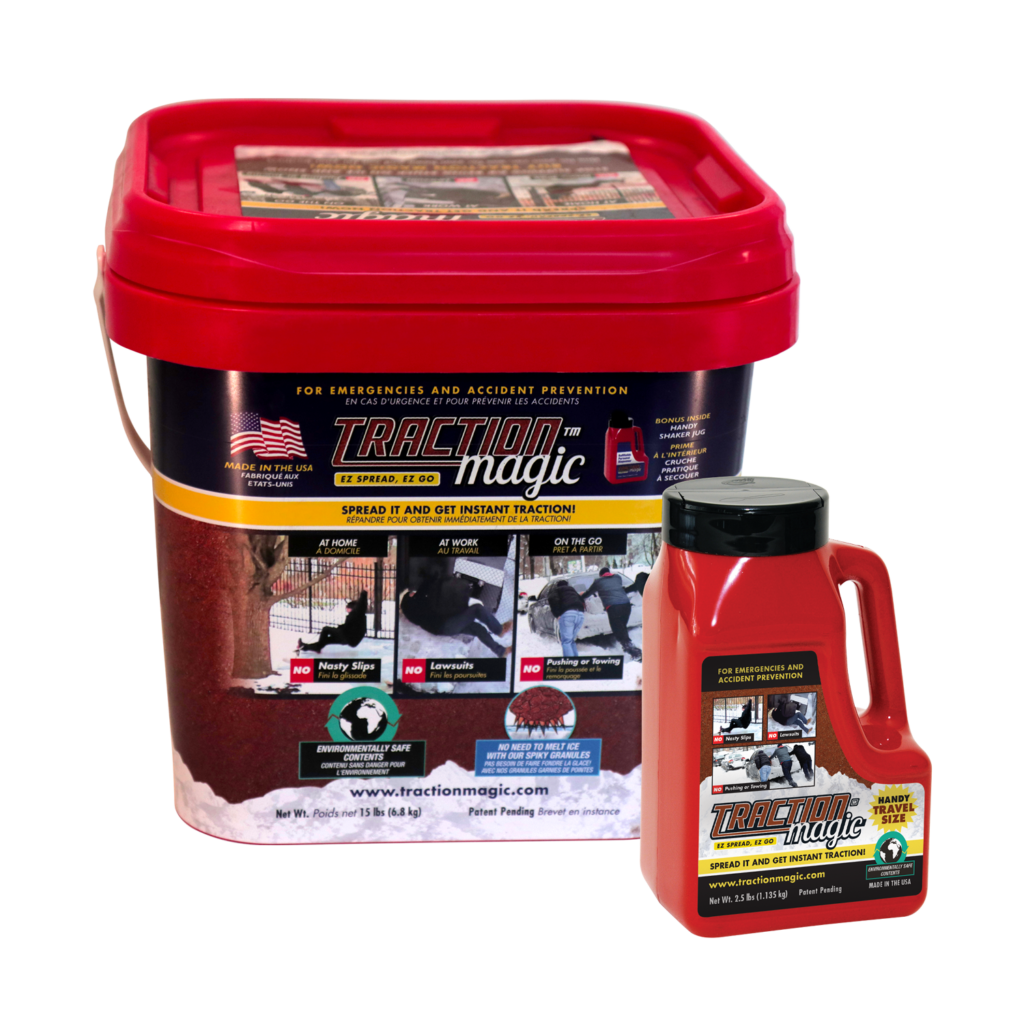
Walk On Ice
The handy disposable canister can be taken everywhere, with the same 100% naturally occurring minerals that provide instant traction on ice or snow. Use it on sidewalks, steps, or as an instant traction agent for your car.
